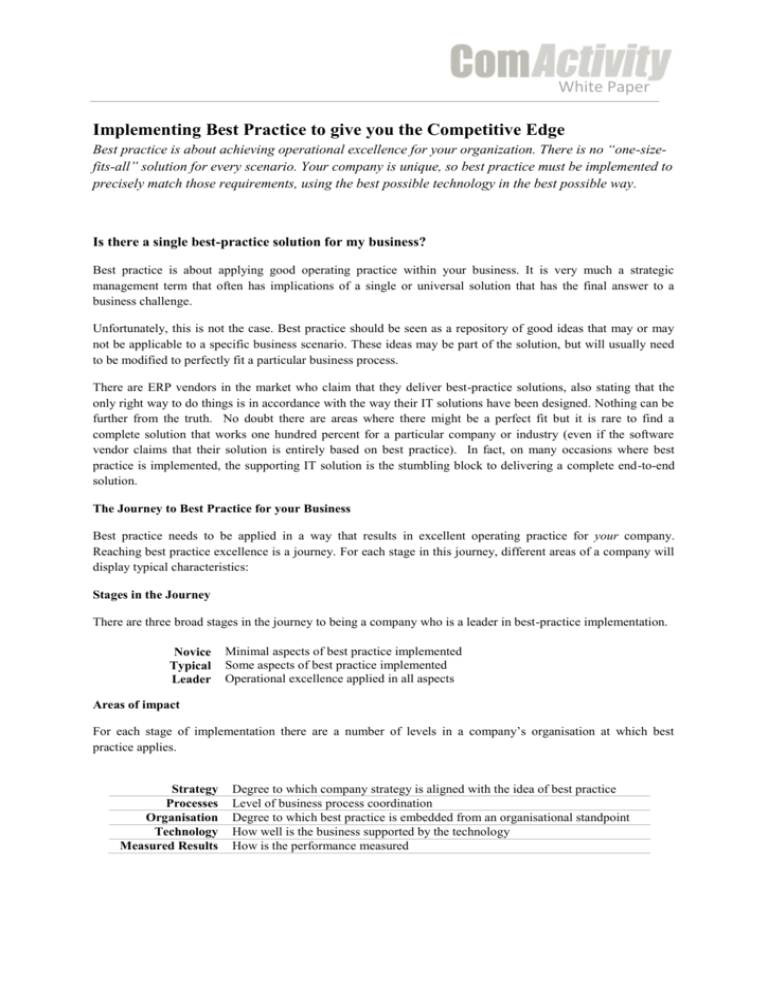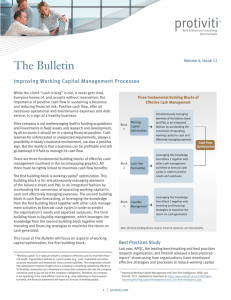read white paper
advertisement

White Paper Implementing Best Practice to give you the Competitive Edge Best practice is about achieving operational excellence for your organization. There is no “one-sizefits-all” solution for every scenario. Your company is unique, so best practice must be implemented to precisely match those requirements, using the best possible technology in the best possible way. Is there a single best-practice solution for my business? Best practice is about applying good operating practice within your business. It is very much a strategic management term that often has implications of a single or universal solution that has the final answer to a business challenge. Unfortunately, this is not the case. Best practice should be seen as a repository of good ideas that may or may not be applicable to a specific business scenario. These ideas may be part of the solution, but will usually need to be modified to perfectly fit a particular business process. There are ERP vendors in the market who claim that they deliver best-practice solutions, also stating that the only right way to do things is in accordance with the way their IT solutions have been designed. Nothing can be further from the truth. No doubt there are areas where there might be a perfect fit but it is rare to find a complete solution that works one hundred percent for a particular company or industry (even if the software vendor claims that their solution is entirely based on best practice). In fact, on many occasions where best practice is implemented, the supporting IT solution is the stumbling block to delivering a complete end-to-end solution. The Journey to Best Practice for your Business Best practice needs to be applied in a way that results in excellent operating practice for your company. Reaching best practice excellence is a journey. For each stage in this journey, different areas of a company will display typical characteristics: Stages in the Journey There are three broad stages in the journey to being a company who is a leader in best-practice implementation. Novice Typical Leader Minimal aspects of best practice implemented Some aspects of best practice implemented Operational excellence applied in all aspects Areas of impact For each stage of implementation there are a number of levels in a company’s organisation at which best practice applies. Strategy Processes Organisation Technology Measured Results Degree to which company strategy is aligned with the idea of best practice Level of business process coordination Degree to which best practice is embedded from an organisational standpoint How well is the business supported by the technology How is the performance measured Supply Chain Metrics One key aspect of implementing best practice or business process excellence to Supply Chain organisations is introducing accurate measures. These measures need to be tailored for different specific processes and companies. Typical measures would be: On-time delivery Order fulfilment lead time Upside production flexibility Total supply chain management costs Cash-to-cash cycle time Forecast Accuracy Returns measures – time, quantity,cost Financial Metrics Conclusion It is a mistake to think that applying best practice to your company can be achieved just by implementing software that claims to be a best-practice solution. It would be nearly impossible for “ a best-practice software solution” to be a complete fit for your business. True best practice can only be achieved by reviewing the unique requirements of your business. Processes, strategy, and the organisation must be fully coordinated in the adoption of best practice, performance must be measured, and the technology must support all of this. Author Profile: Christer Liden eg: Christer Liden is ComActivity’s CEO. Widely-recognised as an expert in the field of business process improvement, he has consulted to a number of leading organisations in Australia and Europe.






